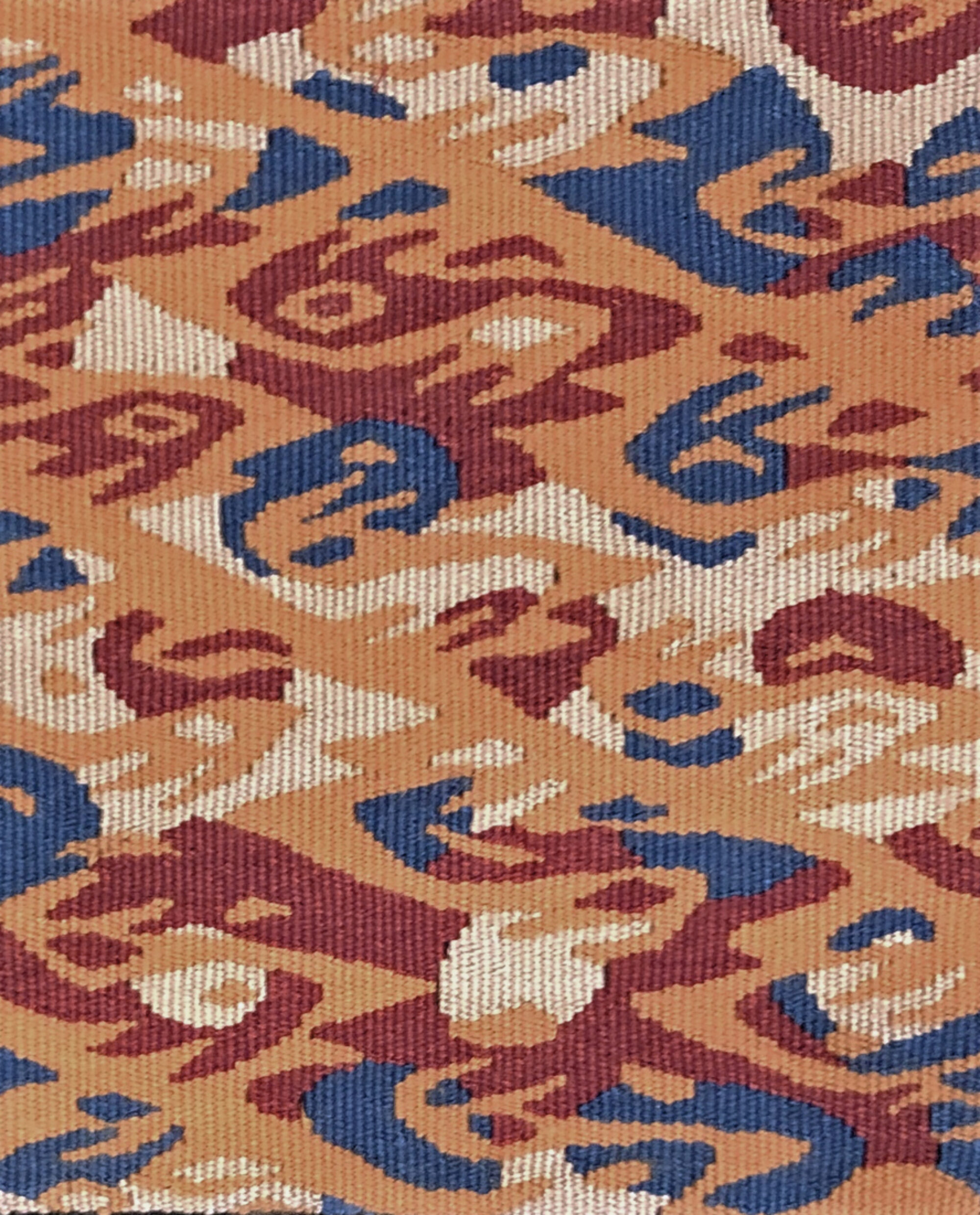This article was first published in the American Tapestry Alliance newsletter, Tapestry Topics, Vol. 29, Nos. 2&3, Summer 2003.
Elinor Steele weaves richly colored, striking tapestries that reveal a careful and methodical artistic process. The Vermont artist studied Fine Art at the University of New Hampshire and was a student of Archie Brennan at the Edinburgh College of Art.1 She is one of a growing number of artists who has embraced technology as an ally in design, using the computer to create and manipulate images. Steele develops the designs for her tapestries in Adobe Photoshop, a powerful computer program that offers seemingly unlimited resources for drawing, painting and the manipulation of scanned images. A Wacum stylus (a mouse in the form of a pen) offers her greater control over drawn lines.2
One of the fundamental working concepts in Photoshop is layers. Layers allow you to separate, and control independently, different parts of the image. Because the layers sit on top of one another, like the strata in an archaeological dig, they lead naturally to the development of overlapping forms and merged images.
Steele’s earlier works, Confetti Moon and Out There, are broad square compositions consisting of overlapping, geometric shapes. The square is a very stable form, four right angles, four equal sides. People who work in a square format often turn the image round and round as they work so that it conceivably could be viewed from any orientation. This is certainly the case with these two tapestries. In Confetti Moon the artist repeats the number four by developing four layers in the image, three squares and one circle. The three squares sit flat like frames, directing our attention to the inner celestial orb, which, because it is shaded, hovers over them. However, the positive/negative shift that results from the value changes in the small circles and the shading in the black and white squares punches holes through the layers, offering an additional interplay between flatness and space in the image.
In Out There the visual weight of the dimensional orb is balanced by the slashes which break through the three layers of square, circle, square. The animation of the surface created by the diagonal movement of the colors between the layers is carefully calculated so that the directional force stays focused within the frame of the tapestry. Similarly, the use of the primary triad of red, blue and yellow adds to the sense of stability and completeness. In this tapestry the top lit shading on the central orb no longer allows us to see it as a moon. The subject of the image is form and color.
Geometric images such as Confetti Moon and Out There are related to the more complex mandala forms of Eastern art and religion which are used as meditation tools. The stability and inward concentration of radially symmetrical forms serve as a focus for self contemplation. Color, in this kind of imagery, assumes a symbolic and emotional role, evoking strong moods and intensifying the viewer’s experience of the image.
Steele’s more recent work includes scanned images that have been manipulated in Photoshop. The artist has ventured beyond the fixed stability of the square, but her interest in balance, geometry and layers is still very much evident. In Five Chairs the vertical rectangle suggests the dimensions of the human figure, although the chairs themselves are empty. The image is cropped in a way that the chairs closest to the viewer become framing elements in the design. They are a puzzle. What part of the chair is that? Which way does it face? We work our way out of the jumble of intersecting lines and forms in the foreground to the inviting pair of chairs offering a view of the ocean. The interplay between the cropped chairs and the complete chairs creates a tension between abstraction and representation, fragmentation and completion. Here the triad of red, yellow and blue is joined by green, making four out of three.
In Composition with Barns the simplification of form and the lack of anecdotal detail focus our attention on the geometry of the buildings. The absence of humans lends the image a melancholy air. The presence of a person, however, is implied in both the human made structures and the ordered geometry of the composition which reveals the presence of the artist’s hand. The beautifully expressive horizontal swath suggesting fields and crops offers a more spontaneous counterpoint to the controlled geometry of the buildings and the rectilinear framing of the image.
Steele’s tapestries convey a strong commitment to compositional balance and a deliberate use of color. The rigorous control found in the earlier pieces gives way in the later work to a more lyrical direction which accommodates both control and spontaneity, abstraction and representation.
End Notes
1. Elinor Steele, Artist Statement, n.d.
2. Elinor Steele, Artist Statement, 2003
